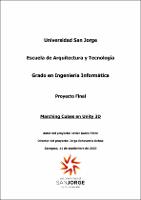Por favor, use este identificador para citar o enlazar este ítem:
https://repositorio.usj.es/handle/123456789/430
Registro completo de metadatos
| Campo DC | Valor | Lengua/Idioma |
|---|---|---|
| dc.contributor.advisor | Echeverría Ochoa, Jorge | - |
| dc.contributor.author | Garzo Pérez, Javier | - |
| dc.date.accessioned | 2020-11-06T13:00:29Z | - |
| dc.date.available | 2020-11-06T13:00:29Z | - |
| dc.date.issued | 2020 | - |
| dc.date.submitted | 2020-09-11 | - |
| dc.identifier.uri | https://repositorio.usj.es/handle/123456789/430 | - |
| dc.description | The Marching Cubes algorithm was originally introduced by William E. Lorensen and Harvet E. Cline in 1987 for 3D rendering of medical data. This algorithm was used for the 3D reconstruction of 2D layer groups generated by medical scanners, although at present the algorithm has opened a small niche in the field of video game development, allowing the generation of editable terrain in real time quickly and cheaply. However, the options to implement it remain difficult because the engines that allow an easy implementation are private or paid to use. Seeking to democratize the Marching Cubes so that developers of any skill can start working on this, the idea of the project was born. The objectives of the project have focused on the creation of a Marching Cubes engine with different properties, such as the creation of a random and infinite terrain and a system for saving the state of the terrain. This set of objectives has been divided into sprints to establish an order and development cost for each element of the engine. The Marching Cubes engine has met all the objectives initially set, allowing it to be stable and simple. The project has reached the basic level expected for the available time and will need extra work to reach the desired professional level. | es_ES |
| dc.description.abstract | El algoritmo de Marching Cubes fue presentado originalmente por William E. Lorensen y Harvet E. Cline en 1987 para la representación 3D de datos médicos. Este algoritmo era usado para la reconstrucción 3D de grupos de capas 2D generadas por escáneres médicos, aunque en la actualidad el algoritmo se ha abierto un pequeño nicho en el campo del desarrollo de videojuegos permitiendo generar terrenos editables en tiempo real de forma rápida y eficiente. Sin embargo, las opciones para implementarlo siguen siendo difíciles debido a que los motores que permiten implementarlo con facilidad son privados o de pago. Buscando democratizar los Marching Cubes para que estén al alcance todo tipo de desarrolladores nace la idea del proyecto. Los objetivos del proyecto se han centrado en la creación de un motor de Marching Cubes con diferentes propiedades, como son la creación de un terreno aleatorio e infinito y un sistema de guardado del estado del terreno. Este conjunto de objetivos se ha dividido en sprints para establecer un orden y coste de desarrollo de cada elemento del motor. El motor de Marching Cubes ha alcanzado todos los objetivos planteados inicialmente, permitiendo que sea estable y sencillo. El proyecto ha alcanzado el nivel básico esperado para el espacio temporal disponible y necesitara de un trabajo extra para alcanzar el nivel profesional deseado. | es_ES |
| dc.format.extent | 106 p. | es_ES |
| dc.format.mimetype | application/pdf | es_ES |
| dc.language.iso | spa | es_ES |
| dc.relation.requires | Adobe PDF | es_ES |
| dc.rights | Attribution-NonCommercial-NoDerivatives 4.0 Internacional | * |
| dc.rights.uri | http://creativecommons.org/licenses/by-nc-nd/4.0/ | * |
| dc.subject | Marching Cubes | es_ES |
| dc.subject | Modelo 3D | es_ES |
| dc.subject | Imágenes 2D | es_ES |
| dc.subject | Videojuegos | es_ES |
| dc.title | Marching Cubes en Unity 3D | es_ES |
| dc.type | info:eu-repo/semantics/bachelorThesis | es_ES |
| dc.subject.unesco | Algoritmo | es_ES |
| dc.subject.unesco | Diseño por ordenador | es_ES |
| dc.subject.unesco | Lenguaje de programación | es_ES |
| dc.rights.accessrights | info:eu-repo/semantics/openAccess | es_ES |
| Aparece en las colecciones: | Grado en Diseño y Desarrollo de Videojuegos | |
Ficheros en este ítem:
| Fichero | Descripción | Tamaño | Formato | |
|---|---|---|---|---|
| Javier Garzo Pérez -Marching cubes en Unity 3D.pdf | 3,58 MB | Adobe PDF |  Visualizar/Abrir |
Este ítem está sujeto a una licencia Creative Commons Licencia Creative Commons

